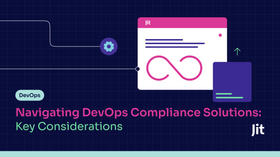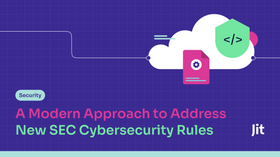A Primer for Navigating ISO 27001
ISO 27001 is a globally recognized framework that encompasses people, processes, and IT systems by applying risk management procedures.
Updated July 23, 2024

ISO 27001 is a prominent cybersecurity framework that plays a crucial role in helping businesses manage and protect their information assets. As the international standard for information security management systems (ISMS), ISO 27001 provides a systematic approach to managing sensitive company information so that it remains secure.
Why Bother With ISO 27001?
This framework encompasses people, processes, and IT systems by applying a risk management process, and is globally recognized for establishing, implementing, maintaining, and continually improving security.
Organizations and DevSecOps professionals adopt ISO 27001 to enhance their security posture and demonstrate their commitment to stakeholders, customers, and partners. Compliance with this standard helps significantly reduce the risk of security breaches that can damage reputations and incur financial costs.
By adhering to ISO 27001, companies can show that they have implemented best-practice information security processes.
This standard is crucial for not only preventing but also effectively managing security incidents when they occur, thus ensuring business continuity, minimizing damage, and maximizing return on investments.
» Need more help? Discover the 6 DevSecOps best practices
Challenges to Implement ISO 27001
The most notable challenge is the extensive need to develop comprehensive internal policies for information security management. Organizations must methodically assess their information security risks, considering threats, vulnerabilities, and impacts to establish effective security controls and risk treatment methods.
Defining these policies can be daunting, requiring a deep understanding of internal operations and alignment with business objectives.
Of course, automated solutions like Vanta and Drata can alleviate these challenges by streamlining policy generation and management. These platforms provide templates and tools that help organizations quickly develop and implement ISO 27001-compliant policies, saving time and reducing errors.
Core Risk Management Processes in ISO 27001
ISO 27001 emphasizes a structured approach to risk management, which is central to the effectiveness of an information security management system (ISMS). This involves identifying potential risks to information security and implementing appropriate measures to mitigate them.
Specifically, ISO 27001 is divided into 14 sections, totaling 114 topics (or requirements). We won’t cover all of them here, but we’ll review some of the core requirements that can make a measurable impact on your security posture.
1. Human Resource Security
Human resource security is a critical component of ISO 27001. It focuses on reducing the risks associated with insider threats and ensuring that all employees are equipped to uphold the organization's security protocols. This involves rigorous screening and ongoing training to foster a security-aware culture.
- Screening for employees: Effective screening processes help prevent potential security threats from within, ensuring all new hires meet established security standards.
- Training and educating employees: Continuous education on security practices helps maintain awareness and reduces the risk of security breaches caused by human error.
2. Asset Management
The careful tracking and management of assets is vital for securing resources and ensuring that all items are accounted for. This can be critical in preventing unauthorized access and effectively managing security breaches.
A detailed inventory helps track all assets and ensures each one is under the control of a designated responsible party, which is critical for responding to security incidents promptly.
>> Dive deeper into the challenges and benefits of attack surface management, which is closely related to asset management.
3. Cryptography
Cryptography is essential for safeguarding the confidentiality, integrity, and authenticity of information. It involves employing strong encryption standards such as AES and managing cryptographic keys effectively to protect data against unauthorized access and breaches.
- Define cryptographic controls: Specifying which cryptographic methods to use can help secure sensitive data effectively against unauthorized access.
- Key management lifecycle: Proper management of cryptographic keys prevents unauthorized access to encrypted data, maintaining confidentiality and integrity.
4. Protection from Malware
Ensuring robust defense against malware and malicious code is integral to protecting organizational infrastructure from potentially devastating attacks. Endpoint detection solutions like CyberReason and CrowdStrike safeguard systems against malware, which is critical for preventing data breaches and maintaining system integrity.
5. Security in Development and Support Processes
Incorporating security measures throughout the software development lifecycle is essential to minimize vulnerabilities and enhance the overall security of software products.
By implementing security into the software development lifecycle, you can ensure that all phases, from design to deployment, are conducted under strict security guidelines.
» Don't fully understand? Make sure you know the SDLC categories and tools
System security testing is integral to ensuring that all code and systems are robust against potential security threats before they go live. This rigorous testing is necessary to catch vulnerabilities that could compromise the security of the software and the data it handles.
Example policies under system security testing:
Scanning every pull request to detect security issues before integration
New code cannot be merged until critical vulnerabilities are fixed, ensuring that security is prioritized
Secrets cannot be committed into the codebase to prevent the exposure of sensitive information
Open source components with critical vulnerabilities cannot be merged, maintaining the security integrity of external dependencies
6. Vulnerability Management
Effective vulnerability management is crucial for identifying, assessing, and mitigating risks associated with security weaknesses before they can be exploited. You should define responsibilities and procedures and conduct regular assessments of the information security events to proactively manage and respond to vulnerabilities.
Learn about seven steps to implement effective vulnerability management.
Streamlining Risk Management: Automating Key Security Processes
Automating risk management processes not only streamlines operations but also ensures consistent and continuous security monitoring and response. By integrating advanced tools into these processes, organizations can proactively manage risks and address security issues with greater efficiency and reduced human intervention.
1. For Security in Development and Support Policy
Implementing security directly into the development and support processes is crucial for identifying and mitigating risks early in the software lifecycle. This is achieved by using various specialized tools:
» Learn more about the top SAST tools and DAST tools
2. For Asset Management
Effective asset management is automated through tools that can monitor and manage the security of IT assets across the network:
» See our top continuous security monitoring tools
3. For Incident Management
Rapid and effective incident management is facilitated by using tools designed to detect, respond to, and mitigate security incidents:
Doing It With Jit
Implementing ISO 27001 can be streamlined significantly with Jit, a platform that integrates seamlessly into existing development workflows to automate and simplify compliance and security processes. By using Jit, organizations can deploy a comprehensive security strategy quickly and efficiently, ensuring all aspects of the ISO standard are met without the heavy manual overhead.
Minimal Viable Security Plan
Our Minimal Viable Security Plan (MVS) is designed to quickly elevate an organization's security to a baseline level of compliance with established standards like ISO 27001.
By providing essential product security controls that are easy to implement and manage, the MVS plan ensures that organizations can meet critical security requirements without extensive customization or prolonged setup times. This plan is ideal for companies looking to enhance their security posture efficiently while maintaining focus on their core business operations.
» Learn more about Minimum Viable Security
- Baseline security controls: Jit offers a set of fundamental product security controls that every organization can implement liek SAST, SCA, and secrets detection (among many others). These controls form a baseline of security that meets the minimum requirements for protection against common threats.
- Rapid deployment: The MVS framework is designed for quick implementation, allowing organizations to reach compliance baselines in minutes rather than months.
- Seamless integration: Jit facilitates the integration of security controls into development environments, interacting directly with IDEs, pull requests, and runtime processes, which simplifies the adoption of security practices throughout the software development lifecycle.
Navigate ISO 27001 Faster With Jit
Adopting a framework like ISO 27001 not only enhances an organization's security posture but also demonstrates a commitment to safeguarding data for stakeholders and customers. By systematically applying the guidelines provided by ISO 27001, businesses can significantly reduce the risk of security breaches and improve their overall information security management. With the right automated strategies and tools, like Jit's Minimal Viable Security Plan, navigating the complexities of ISO 27001 implementation can be streamlined.










![AWS FTR (Foundational Technical Review) Checklist [XLS Download]](https://entail.jit.io/en-assets/jit/fit-in/280x280/Security_Standards-1747040330047.png)


